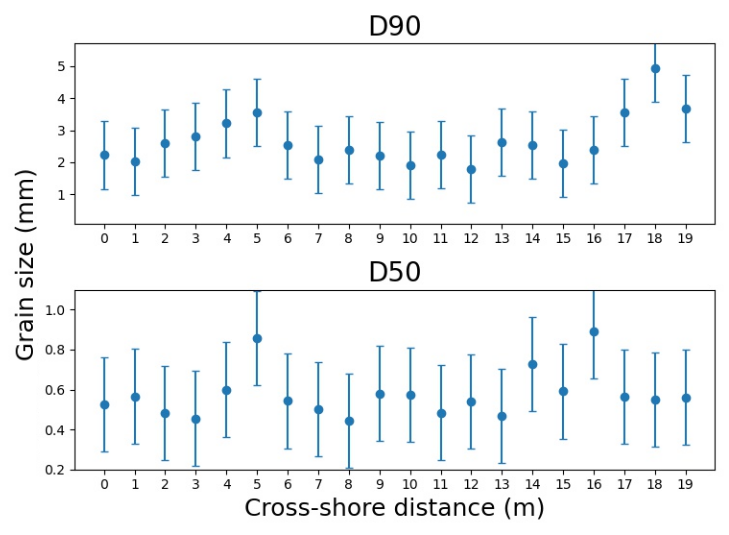C.F. Bakker*, J.W. Bosma, T.D. Price
Utrecht University;
*corresponding author:
Introduction
The traditional approach for grain size analysis, mechanical sieving, is a time-consuming process that limits its spatial and temporal resolution. Here, we used a method that determines the grain size distribution from just images of the sediment surface (i.e., optical granulometry), called pyDGS (Buscombe, 2013). We developed a new method to convert the area-by-size measure of pyDGS to the volume-by-weight measure obtained by sieving, enabling their direct comparison. The Prins Hendrikzanddijk, a poorly sorted sandy beach, was used as a case study to test the performance of this novel (adapted) method, and its applicability for mapping grain-size distribution at an entire beach.
Methods
A photo of sediment captures a certain area and pyDGS computes the percentage of each grain size class within this frame by fitting translated and scaled wavelets. To convert this information into useful statistics, the following steps are taken for all grain size categories in an image: 1) calculate the total number of grains in the photo frame, 2) estimate the volume of each grain class, and 3) compute the mass of each grain size category by multiplying the number of grains by their volume and density. In this study, the grain shape was estimated and calibration was done with sediment samples that were photographed and sieved.
Results
Figure 1 shows the potential of this new method by displaying the results of high-resolution spatial sampling. Despite the relatively large standard deviations, the relative patterns are apparent. As such, the results are promising for detailed and time-efficient mapping of spatiotemporal trends in volume-by-weight measures of grain sizes .

Figure 1: Cross-shore distribution of grain sizes acquired with the new method (note: 0 and 19 m correspond to the high and low waterline, respectively).
References
Buscombe, D. (2013). Transferable wavelet method for grain‐size distribution from images of sediment surfaces and thin sections, and other natural granular patterns. Sedimentology, 60(7), 1709-1732. https://doi.org/10.1111/sed.12049
I. Surname1*, F.N. Another-Surname2 , Y. Next-Surname2
1 University Name, Country; 2 Organization Name, Country
* Corresponding author: mail.name@organization.org


